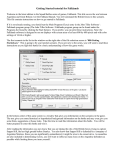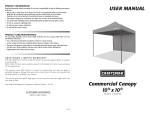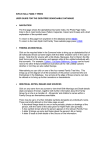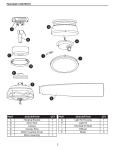Download Evo Canopy User Manual - Evo Canopy Inflatable Tents
Transcript
Thank you for choosing Evo Canopy! In order to ensure optimal functionality, long product performance and safety of your air compression canopy, it is important to follow all guidelines. Please thoroughly read the “User Guide” prior to first operation. If you have any questions regarding your canopy please contact our team anytime 888.881.7535 or online at www.evocanopy.com. Thanks again. GENERAL 1.0 The Evo Canopy is not intended for permanent set-up. 1.1 Your canopy may require added air at various times depending on climate conditions. 1.2 Do not exceed the maximum air pressure of 3 PSI. (it is recommended to always do a thumb test – you should be able to compress the air tubes slightly with your thumb). 1.3 The canopy is not intended for use in high wind conditions. If you think it is not safe, it is likely unsafe to inflate. 1.4 Keep open source heat, especially fire away from the Canopy. The canopy meets CPAI-84 standards but it is NOT FIREPROOF. The CPAI-84 fulfills the international requirements for flame resistance in canopy products. 1.5 Be aware of sharp objects. Penetration by any sharp object into the air tubes will jeopardize the air tubes. Always handle with care. SET-UP & INFLATION 2.0 Remove the canopy from the transportation backpack and extend each leg. 2.1 Make sure the surface is acceptable for stability. On asphalt be conscious of the canopy from rubbing against the ground or possible sharp objects. Never walk or place pressure on the canopy during set-up and breakdown. 2.2 Locate each valve to ensure they are closed. 2.3 In conditions which winds are a factor, make sure to secure legs to prevent the canopy from moving. 2.4 Check each air tube to make sure it is not twisted. 2.5 During inflation, you will unscrew the top cap on the valve only. The top cap allows for one-way inflation only. 2.6 Always inflate the center peak valve first. Inflating your canopy can be accomplished with your electric pump or dual action hand pump. Note: the dual-action hand pump has a much higher PSI rating – make sure you are aware of you inflation pressure. 2.7 Assist the canopy vertical from the center position as it completes inflation if necessary. 2.8 Confirm pressurization on each leg and close the top inflation valve. 2.9 Stabilize each leg with appropriate stake or ballast bag through the canopy tie rings located at the base of each leg. It is recommended to use the guy-line to add additional stability when necessary. ATTACHING ACCESSORIES 3.0 Remove your accessories from there storage bag and determine where each accessory attachment will be placed. 3.1 When attaching side panels, make sure the zippers are aligned properly before attempting to close the zipper. 3.2 Grasp the zipper with the slider only when securing. Pull the zipper slowly to ensure you do not catch the trim as you close. If you do, slide the zipper back slowly and begin again. 3.3 When the zipper is closed, or at desired attachment, connect the straps on the outside of the canopy to the other side panels or the canopy. Adjust the ladder buckles to desired tension. 3.4 Attaching the canopy connects are done in the same fashion as the side panels. It is recommended to stake each side of the canopy connect to provide stability. 3.5 When using the marquee; insert the batons into webbing pocket, zip the marquee onto the canopy, inflate the arch, secure support arm to the canopy peak and inflate. IN-USE 4.0 Periodically check the air pressure in each leg using the thumb test. If more air is needed, open the top valve only at the leg base and inflate. 4.1 When the canopy is being used in sandy locations take extra caution not to let sand get inside the air tubes or the valves. The sand can cause friction causing the tubes to leak air. 4.2 In the situation of an air leak or loss of pressure: - Confirm all of the valves are closed tightly. Do not over tighten the valves; this could cause the valve to weaken the air bladder. - 4.3 If the air bladder is determined to be the issues follow the steps under repair to fix the leak. Periodically check your stabilization to ensure proper safety and tension. DEFLATING & PACKING 5.0 Prior to deflation and storing, confirm the surface is stable clear of any sharp objects. 5.1 Remove any accessories such as canopy connects, marquess or side panels. Always unzip slowly! 5.2 Fold your accessories and store in their appropriate storage bag. 5.3 Open the same valve in which you inflated the canopy. Make sure you open the valve closet to the air tube – this is a two way valve and will allow for the air to escape. 5.4 The canopy will quickly deflate and fall to the surface. 5.5 Walk around to each air tube leg and open the same valve on each leg. 5.6 Remove the securing stakes or ballast bags from the air tubes and canopy. If the conditions are windy, you can remove them one by one as you position the tent for storing. 5.7 Position the canopy and air tubes on top of each other making sure they are all aligned. 5.8 Begin folding your canopy from the top. Allow for a larger fold at the peak to ensure the valves are not on the crease line. Avoid stepping or knelling on the canopy. We recommend folding the canopy twice to ensure all of the air has escaped. Once you complete the folding, tighten the valves so no debris or air can enter into the bladder and place in your transportation bag . 5.9 Once all items are placed in the transportation bag, close the zipper and use the straps to compress the bag. Do not pack the canopy in wet or moist conditions. STORING 6.0 Do not store the canopy in extreme heat or in an area of direct sunlight. This can cause the materials to stick together and damage the fabric 6.1 Store your canopy in a low humidity location. MAINTENCE 7.0 We recommend periodic inspections on your canopy to ensure no debris or penetrations exist. 7.1 When recommend wiping down your canopy prior to packing and storing. 7.2 Use only warm water and a soft cloth to clean your canopy. Do not use bleach, solvents or machines to clean the canopy. REPAIRS 8.0 In the event of an air leak you can use the repair kit to patch small leaks. Follow the steps to accomplish this task: 8.1 Because the canopy requires significant pressure you can listen for the air leak location. Determine the air tube which is in need of a patch and remove the bladder. To remove the air bladder: - Begin by opening the Velcro slot in the proximity of the air valve(s) Unscrew the valve caps and remove them from the valve – you will need to pull the connection ring off of the valve. Push the valve through the valve opening slowly and separate the Velcro Perform the same task at the opposite end of the leg (near the peak of the canopy) Start by removing the ends of the air tubes through the Velcro opening Tie a string at one end of the air tube slots (this will be used to pull the air tube back into position). Replacement can be done without the string with just your arm/hand. Begin pulling the air bladder slowly through the air tube. Once you remove the bladder, inflate to locate the leak and use your patch kit to repair. The patch kit includes: wipes to clean the bladder surface and TPU bladder patch. Allow for one hour for drying time before replacing the bladder. Reverse the steps to replace bladder. Be aware to not twist the bladder during the replacement process. Always inflate the bladder slowly to ensure it is not twisted.













